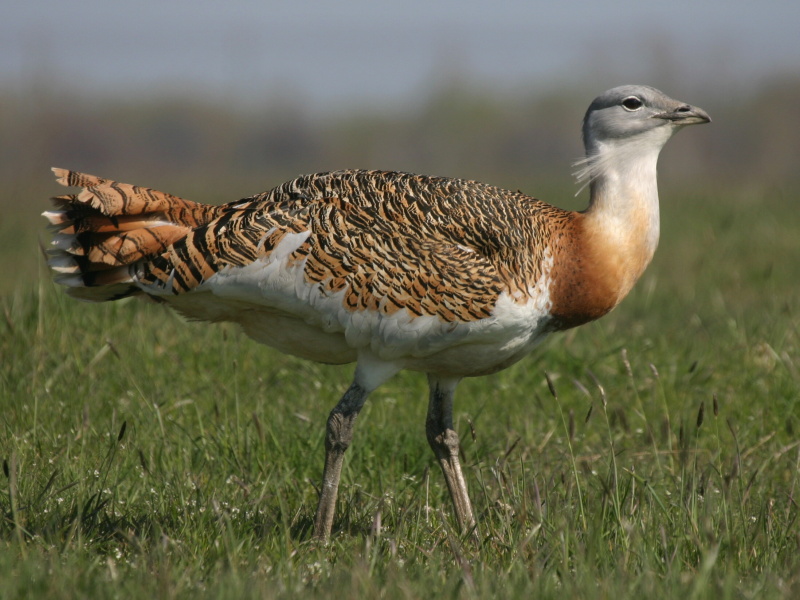Hello ladies and gents this is the Viking telling you that today we are talking about
THE GREAT BUSTARD
The great bustard (Otis tarda) is a bird in the bustard family, the only member of the genus Otis. It breeds in open grasslands and farmland from northern Morocco, South and Central Europe, to temperate Central and East Asia. European populations are mainly resident, but Asian populations migrate farther south in winter. It has been listed as Vulnerable on the IUCN Red List since 1996.
Portugal and Spain now have about 60% of the world's population. It became extinct in Great Britain when the last bird was shot in 1832. Recent attempts to reintroduce it into England have met with some success and there is a population of 40 birds on Salisbury Plain, a British Army training area. Here the lack of public access allows them the freedom needed as a large ground-nesting bird.
The adult male great bustard is amongst the heaviest living flying animals. A male is typically 90–105 cm (2 ft 11 in–3 ft 5 in) tall, with a length of around 115 cm (3 ft 9 in) and has a 2.1–2.7 m (6 ft 11 in–8 ft 10 in) wingspan. The male can range in weight from 5.8 to 18 kg (13 to 40 lb). The heaviest verified specimen, collected in Manchuria, was about 21 kg (46 lb), a world record for heaviest flying bird. In a study in Spain, one male weighed as much as 19 kg (42 lb).
Larger specimens have been reported but remain unverified. Average male weights as reported have been fairly variable: in Russia, males weighed a median of 9.2 kg (20 lb); in Spain, males weighed a mean of 9.82 kg (21.6 lb) during breeding season and 10.62 kg (23.4 lb) during non-breeding; in Germany, males weighed a mean of 11.97 kg (26.4 lb); and the Guinness World Records has indicated that prior to their extirpation male bustards in Great Britain weighed an average of 13.5 kg (30 lb).
Average weight of males is almost an exact match to that of male Kori bustards. Among all flying animals and land birds, male Andean condors (Vultur gryphus) may match or exceed the mean body masses of these male bustards but not their maximum weights. Furthermore, male swans of the two largest species (trumpeter and mute) may attain a similar average mass depending on season and region.
Among both bustards and all living birds, the upper reported mass of this species is rivaled by that of the kori bustard (Ardeotis kori), which, due to its relatively longer tarsi and tail, is both longer and taller on average and is less sexually dimorphic. In terms of weight ranges reported, the great Indian bustard (Ardeotis nigriceps) also only lags slightly behind these species.
The great bustard is also arguably the most sexual dimorphic extant bird species, in terms of the size difference between males and females. Adult male great bustards measured in Spain weighed on average 2.48 times more than females.
Going on mass, the only known bird with a higher dimorphism is the green peafowl (Pavo muticus) as the males are apparently near four times as heavy as females. The female is about a third smaller in linear dimensions, typically measuring 75 to 85 cm (2 ft 6 in to 2 ft 9 in) in height, about 90 cm (2 ft 11 in) in length and 180 cm (5 ft 11 in) across the wings. Overall, the female's weight can range from 3.1 to 8 kg (6.8 to 17.6 lb).
Like male weights, females weights are quite variable as reported: in Germany, females had a mean weight of 3.82 kg (8.4 lb), in Spain, females had a mean weight of 4.35 kg (9.6 lb) and in Russia, females reportedly had a median weight of 6 kg (13 lb). The latter figure indicates that eastern birds (presumably O. t. dybowskii) are considerably less sexually dimorphic in body mass than in other populations. Perhaps because of this physical sexual dimorphism, there is a skewed sex ratio of about 1.5:1 female to male.
An adult male is brown above, barred with blackish colouration, and white below, with a long grey neck and head. His breast and lower neck sides are chestnut and there is a golden wash to the back and the extent of these bright colours tending to increase as the male ages. In the breeding season, the male has long white neck bristles, which measure up to 12–15 cm (4.7–5.9 in) in length, continually growing from the third to the sixth year of life.
In flight, the long wings are predominantly white with brown showing along the edges of the lower primary and secondary feathers and a dark brown streak along the upper-edge of the wing. The breast and neck of the female are buff, with brown and pale colouration over the rest of the plumage rendering it well camouflaged in open habitats. Immature birds resemble the female. The eastern subspecies (O. t. dybowskii) is more extensively grey in colour in both sexes, with more extensive barring on the back.
The great bustard has long legs, a long neck and a heavy, barrel-chested body. It is fairly typical of the family in its overall shape and habitat preferences. Three other bustard species overlap in range with this species: the Macqueen's (Chlamydotis macqueenii), houbara (Chlamydotis undulata) and little bustards (Tetrax tetrax). However, none of these attains the plumage coloration nor approach the body sizes of this species. Thus, the great bustard is essentially unmistakable.
And as always have a chilled day from the viking.

Comments
Post a Comment